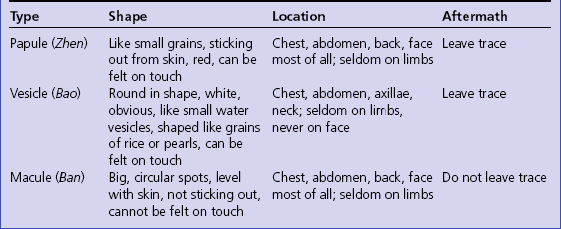Chapter 104 Many warm diseases often manifest with a rash; examples of exanthematous (i.e. manifesting with rash) diseases are measles, German measles and chickenpox. One must distinguish between vesicles, papules and macules (see Table 104.6). Vesicles are blister-like spots filled with a clear fluid and they always indicate Dampness. Papules are red, solid spots; they generally indicate Heat at the Qi Level (and especially in the Lungs and Stomach). Macules are spots under the skin which, unlike vesicles and papules, cannot be felt on palpation; they always indicate Heat at the Nutritive-Qi or Blood level. LI-4 Hegu, LI-11 Quchi, TB-5 Waiguan, Du-14 Dazhui, BL-12 Fengmen (with cupping), LU-11 Shaoshang. Yin Qiao San Lonicera-Forsythia Decoction Sang Ju Yin Morus-Chrysanthemum Decoction. Table 104.1 compares the manifestations of Wind-Heat with those of Wind-Cold (Six Stages). Table 104.1 Comparison of invasion of Wind-Cold (Six Stages) and invasion of Wind-Heat (Four Levels) Tongue Sticky white coating. The tongue coating is white because the pathogenic factor is on the Exterior. Pulse Soggy-Slow. The pulse is Slow because of the influence of Dampness.
 IDENTIFICATION OF PATTERNS ACCORDING TO THE FOUR LEVELS
IDENTIFICATION OF PATTERNS ACCORDING TO THE FOUR LEVELS
INTRODUCTION
DEFENSIVE-QI LEVEL
Wind-Heat
Acupuncture
Prescription
Wind-Cold (Six Stages)
Wind-Heat (Four Levels)
Pathology
Wind-Cold on Exterior obstructing Defensive Qi
Wind-Heat injuring Defensive Qi and impairing descending of Lung-Qi
Penetration route
Through skin
Through nose and mouth
Fever
Slight or absent
Higher
Shivers
Severe
Slight
Aches
Severe (in prevalence of Cold)
Slight
Headache
Occipital
Deep inside, severe
Sweating
No sweating in prevalence of Cold; sweating only on top part of body in prevalence of Wind
Slight sweating
Thirst
No
Slight
Urine
Clear
Slightly dark
Tongue
Body-colour normal, thin white coating
Red sides/front, thin white coating
Pulse
Floating-Tight in prevalence of Cold; Floating-Slow in prevalence of Wind
Floating-Rapid
Treatment
Pungent-warm herbs to cause sweating
Pungent-cool herbs to release the Exterior
Damp-Heat
Clinical manifestations
IDENTIFICATION OF PATTERNS ACCORDING TO THE FOUR LEVELS




